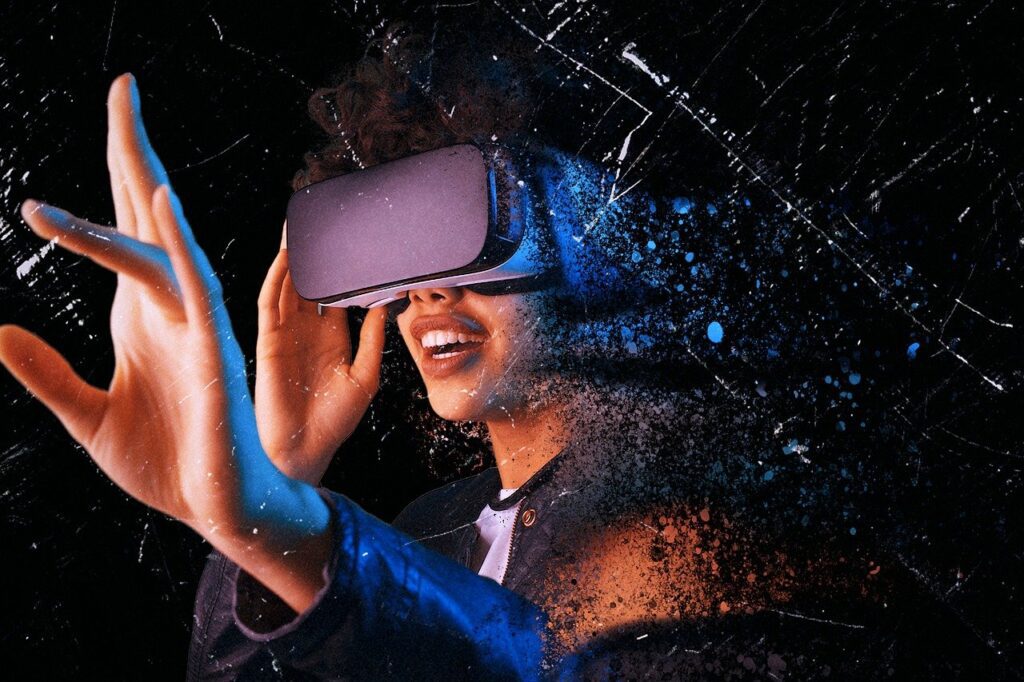In today’s changing and evolving digital landscape, the world is more connected than ever. Mere 15 years ago, the concept of household appliances and wearables with internet access was an alien one, but they’re growing more common than ever.
As technology continues to advance exponentially fast in many areas, the creation of virtual worlds has become increasingly accessible for developers looking to dip their toes in what many call the future of the internet. This is further pushed by recent improvements in extended reality, artificial intelligence, and cloud computing technologies, paving the way for widespread adoption of these realms.
In this article, we’ll talk about virtual world development and some of its most promising applications. Down the line, we’ll also explain their design and development processes, going into key considerations and the main tools and technologies at play.
Virtual world development: what is it all about?
The process of designing, developing, and assembling a digital realm that mimics real-world or fictional spaces is called virtual world development. It encompasses a wide range of disciplines, such as storytelling, psychology, user experience design, programming, art, music, networking, and many more, all working harmoniously to bring these highly immersive worlds to life.
At its core, virtual world development is about creating engaging and interactive experiences that transport users into another world. Furthermore, they usually offer users the freedom to explore and engage with many objects within the world – or maybe even shape parts of the world itself.
Over the last few years, the concept of a shared, persistent, and highly interconnected digital world has stolen the headlines. Known as the metaverse, the platform aims to create a seamless and immersive experience where users can interact with each other and the environment in real-time, which further blurs the boundary between the real and the digital.

How are virtual worlds important? Applications of virtual worlds
Surprisingly to some, these virtual worlds have the potential to change our approach to many aspects of their lives:
Gaming and entertainment
One of the most widespread examples of virtual worlds, games have long been synonymous with them, providing countless hours of entertainment to billions around the world.
From casual gaming experiences to hardcore MMORPGs, virtual realms serve as a platform for players to go on epic journeys, compete in virtual sports, or engage in party games with friends from the comfort of their houses.
While the technology is still being developed, one of the leading examples is Roblox, a metaverse platform that lets players create experiences of their own and play whatever others have created. It’s such a big name in the gaming industry it averages 66 million daily active users according to Demand Sage.
Education and training
Virtual worlds have the potential to revolutionize the way we approach education and training. While not mainstream yet, some schools have experimented with the technology with great success – especially for medical training according to HealthTech. But how so?
By providing interactive and engaging learning environments, these virtual worlds offer students a way to practice and hone their skills safely – from virtual laboratories to surgery simulations. In many cases, the technology even lets various people collaborate at the same time, which can make learning much more fun.
Socializing and community building
Virtual worlds have also become a staple in the gaming industry, enabling people from around the world to connect, communicate, and have fun within a shared digital space. VRChat, for example, is a platform for many user-generated worlds where people hang out, play games, watch videos together, and so on, which got really popular as the pandemic ground the world to a halt.
Virtual tours
What if you wanted to travel abroad and explore tourist attractions, but for some reason could not? Or maybe something unfeasible, like seeing the daily life of a Roman soldier or a scientist working in a Martian colony? With virtual worlds, it’s just a matter of time until these experiences are available!

Business and commerce
Virtual worlds have also found interesting applications in the world of business. Many companies have used these virtual worlds to hold conferences, trade shows, and product showcases to the public, serving as a great way to market their goods. They also act as a fantastic way to visualize architectural and engineering projects, allowing contractors to see the finished buildings in their glory before construction commences.
Building a virtual world
Conceptualization and planning
Having a concept and a rock-solid plan for a virtual world is the crucial first step in developing them. Here are some key considerations for this step:
- Start by defining the objective of your virtual world. Whether it’s an educational environment, a fully-fledged game, or a virtual hub where people come to socialize, it’s critical to have a clear understanding of the virtual world’s objective as it will guide your upcoming decisions;
- Conduct research to identify possible gaps in the market. By exploring and analyzing successful examples of virtual worlds, you will get a better understanding of the best design practices and user expectations. In turn, this will grant you valuable insights to further refine your initial concept;
- Outline its core features and think about UX. Brainstorm the key functionalities of your virtual world by considering elements like character customization, interactivity with the environment, progression systems, and so on. It’s also a good time to start thinking about user experience as well and put extra effort into making your features feel great;
- Then, establish the visual and artistic direction for your virtual world. Think about the art style, atmosphere, and colors you want for your virtual world, making sure it fits with your intended experience. This is important to create a cohesive and immersive environment where nothing feels out of place;
- Finally, assess the technical requirements of your world. Think about the platform on which it will be built, its hardware requirements, and the tech stack required to create it. Don’t forget to consider factors like performance, security, scalability, integration with other systems, and networking capabilities too.
Developing the digital environment
Once the conceptualization phase ends, development commences to finally bring your world to life. This step is the most hands-on one as it requires people to create assets and implement the code to make it real. Listed below are some of the key aspects of developing virtual worlds:
- Programming and scripting: while some engines already provide built-in functions, they don’t possess the logic to make anything work. Developers will need to implement the required functionality of your virtual world through programming languages like C# (Unity), C++ (Unreal), or another specific to the chosen engine;
- Asset creation: artists will need to create the icons, models, textures, sounds, and background music the player will interact with in your virtual world. This step’s complexity largely depends on the early design choices regarding artistic vision – low poly assets, for example, are much easier to create than realistic ones;
- Environment design: as virtual worlds have three dimensions, it’s important to construct a compelling environment for users. This involves placing assets, lighting places, designing landscapes, and ensuring proper spatial organization so that nothing feels too cluttered or too empty.
- Multiplayer and networking: as interconnected digital experiences, virtual worlds must be connected to the internet in some way. This usually involves establishing communication protocols – a “netcode” – and synchronizing the player actions with the server. Don’t forget to consider a chat and friend list system if not enabled by default, fair matchmaking, and other similar features if applicable;
- Testing: it’s essential to regularly test your creation to ensure everything is working properly with every addition. As your virtual world starts to take shape, expect to identify and squash more and more bugs! Also, make sure to collect feedback from early testers to assess your world’s user experience, which will help you refine the design even further;
- Deployment and distribution: once everything is finished, it’s time to deploy your creation. This step involves packaging all of your world’s assets and code into a deliverable format supported by the target platform. And then it’s a matter of marketing it to the public!

Technologies used to create such worlds
Designing and developing these virtual worlds require the utilization of many technologies to bring them to life. Here are some key software and tools that are commonly used in their development:
- Game engines and development platforms: game engines like Unity (C#), Unreal Engine (C++ and Blueprint, a visual scripting language), and Godot (C#, C/C++, GDScript, and VisualScript) provide a solid foundation for building virtual worlds, coming with hundreds of streamlined built-in functions to let developers work on what matters – the logic;
- Asset creation tools: there are many tools used for asset creation, like Photoshop and Clip Studio Paint for 2D icons, Blender and Autodesk Maya for 3D models and animations, Substance Painter for texturing, and FL Studio and Ableton for composing background scores;
- Extended reality (ER) technologies: virtual reality (VR) and augmented reality (AR) are under the umbrella term ER, and they are critical in creating highly immersive virtual worlds. VR headsets and AR devices let users interact with the virtual world more intuitively, enhancing the sense of presence and immersion;
- Internet of Things (IoT): by connecting physical objects and appliances to the digital realm, players can interact with real-world objects from the virtual world, bringing their interactivity levels off the charts;
- Artificial intelligence (AI): this technology is mostly used to augment the NPCs’ behavior, making them exhibit behaviors that are realistic and believable. With enough information, they could even make decisions taking their context and surroundings into consideration, which further strengthens immersion for players;
- Machine learning (ML): ML algorithms and techniques are extremely useful in procedural content generation, adaptive gameplay systems, and learning from player behavior. The collected data then may be processed to create dynamic and personalized experiences for the user;
Exploring the Boundless Horizons: The Emergence and Potential of the Metaverse
In the rapidly evolving landscape of technology, the concept of a virtual world has transcended mere imagination and is now a tangible reality shaping our daily lives. The development of virtual environments and the future of virtual reality have become intertwined with our understanding of the digital realm. With the advent of advanced headsets and immersive gaming experiences, users can embody avatars and traverse through second life-like virtual spaces in real-time.
The metaverse, still in its early stages, promises a convergence of physical and virtual worlds, where virtual objects coexist seamlessly with the physical environment. Companies are already working tirelessly to harness the potential of the metaverse, envisioning a future where virtual and augmented reality technologies are integrated into every aspect of daily life.
As we imagine the internet centering around the concept of virtual worlds, the metaverse emerges as a shared virtual universe where users can create, explore, and interact with virtual content and virtual identities. While the market for the metaverse is still nascent, the benefits it offers are profound, promising to redefine how we perceive and experience the world.
As we look ahead, the metaverse holds the promise of becoming the new reality, offering us a glimpse into what the future holds and the potential for transformative growth in how we interact with the world around us.
Conclusion
In conclusion, virtual world development is a recent niche in the tech industry, but it’s getting traction and growing bigger by the year – Statista estimates the metaverse’s revenue to surpass 900 billion dollars by 2030.
These worlds have emerged as a powerful and immersive way to offer endless possibilities for entertainment, education, social interaction, and business purposes. As seen in this article, creating them is a tough and arduous process that requires deep planning and lots of technical knowledge, but the result can be otherworldly.
All in all, the potential for virtual worlds to shape our future and be part of our daily lives is massive, and many companies are already trying to tap into this growing market. And if you’re looking to bring your virtual world project to life, you’re at the right place!
At Main Leaf, we’re experts on all things game development, and we’d be happy to provide our services! Our 70+ talented professionals are well-versed in Unity and Unreal Engine, creating fantastic games with them. While we specialize in developing fully-featured games, you may outsource parts of your game or virtual world to us, like game design, asset creation, or even implementing technologies like NFTs and blockchains to your creation.
If you’re interested in working alongside an experienced game studio, contact us below and we’ll get back to you within 24 hours!

